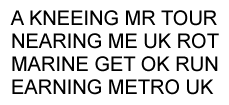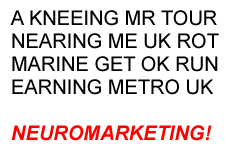Puzzles Boost Brand Recognition
 The Revelation Effect. If you’ve ever solved word puzzles, such as anagrams in which one must unscramble letters to form a word, you’ve probably experienced the little “aha!” rush when you solve one. An interesting article in the Journal of Applied Cognitive Psychology, Unscrambling words increases brand name recognition and preference, shows that simple puzzle solving creates a false sense of familiarity with the brand and actually creates a preference for the brand:
The Revelation Effect. If you’ve ever solved word puzzles, such as anagrams in which one must unscramble letters to form a word, you’ve probably experienced the little “aha!” rush when you solve one. An interesting article in the Journal of Applied Cognitive Psychology, Unscrambling words increases brand name recognition and preference, shows that simple puzzle solving creates a false sense of familiarity with the brand and actually creates a preference for the brand:
When participants had to solve an anagram prior to seeing a target brand, they were more likely to claim to have seen the brand before (Experiment 1), to have known the brand in high school (Experiment 2), and to give higher preference ratings for the brand (Experiments 1 and 2). These results demonstrate that the revelation effect can be applied to brand names and preference judgments.
The work, conducted by Canadian researchers Antonia Kronlund and Daniel M. Bernstein, may suggest some new paths for marketers introducing new brands. Letting potential customers “discover” the brand name in some manner may suggest previous familiarity and even improve preference.
One might wonder how a customer can solve an anagram for an unknown word, i.e., a new brand name that isn’t an actual dictionary word. E.g., does TVINERA unscramble into NEVITRA? TRIAVEN? VENTRIA? The experimental technique addressed this by providing the subjects with a “key,” i.e., the numeric order of the letters for the correct spelling. (E.g., “2541637” decodes TVINERA into VENTRIA.) This, of course, sounds rather like an “Anagrams for Dummies” puzzle that in the real world might be unappealing, say, to the readers of a magazine. Clever marketers can no doubt find some different approaches to this problem. One might be to provide a list of possible solutions, among which the brand name is the only one that fits the letters in the anagram. Another might be to provide an example anagram that the customer would have to use to determine the pattern.
 Non-anagram puzzles might work as well, too. Perhaps a word hidden in a picture that could be discovered after briefly examining the image? Or one of those patterned images that you stare at with unfocused eyes to see a three-dimensional shape emerge? A crossword puzzle with other clues that, when complete, reveals the brand name? Of course, these puzzle variations differ from Kronlund’s experiments, but the procedure to establish their effectiveness wouldn’t be too difficult or expensive. (This is really “neuromarketing lite” compared to fMRI studies and the like.)
Non-anagram puzzles might work as well, too. Perhaps a word hidden in a picture that could be discovered after briefly examining the image? Or one of those patterned images that you stare at with unfocused eyes to see a three-dimensional shape emerge? A crossword puzzle with other clues that, when complete, reveals the brand name? Of course, these puzzle variations differ from Kronlund’s experiments, but the procedure to establish their effectiveness wouldn’t be too difficult or expensive. (This is really “neuromarketing lite” compared to fMRI studies and the like.)
Is it Puzzle Time? I don’t think that incorporating puzzles in the marketing plan for a brand launch will by itself turn that brand into a winner, but, in conjunction with an otherwise appealing and effective campaign, doing so might provide a small boost for some customer segments. Clearly, some individuals are more likely to make the effort to solve a simple puzzle than others; a large portion of those exposed to a puzzle ad may simply bypass it and experience zero exposure to the new brand name.
Puzzles and Infovores. It’s worth noting, too, that discovering a novel brand name after a thought process might also trigger the “infovore” effect, i.e., stimulate the mu-opioid receptors associated with gaining new information. Potentially, this could provide a positive association with the brand and increase preference for that brand.
P.S. Thanks to the Developing Intelligence and Thinking Meat blogs for highlighting this study. Want to generate your own anagrams? Try this nifty anagram tool.
